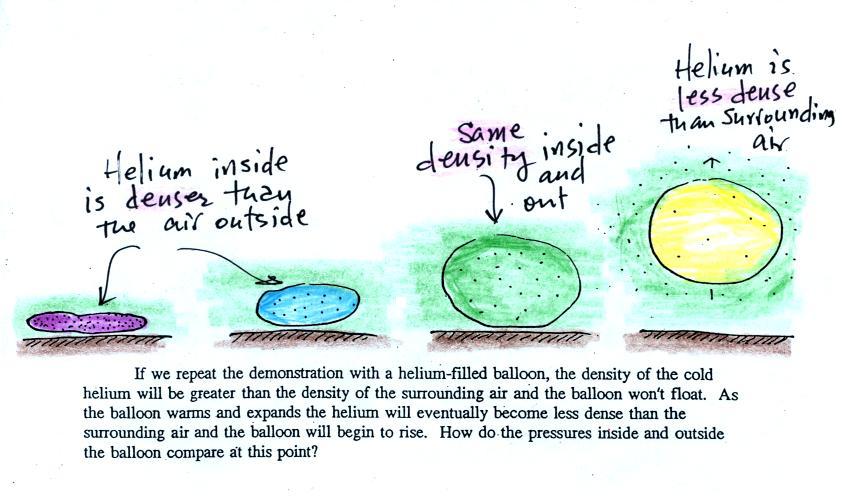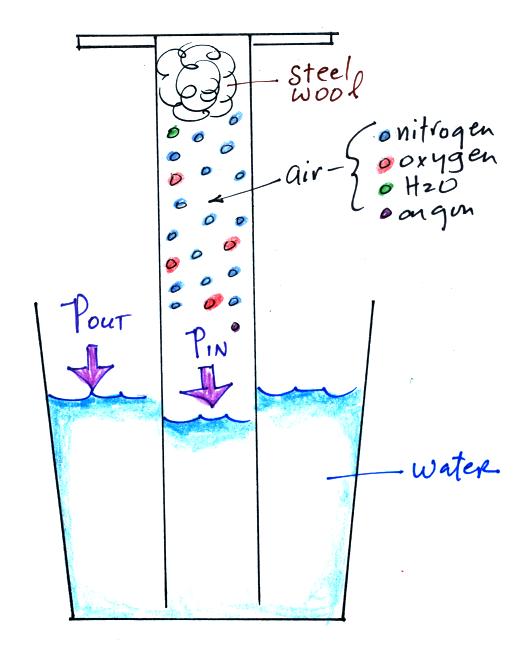
Charles Law can be demonstrated by dipping
a balloon in liquid nitrogen. You'll find an explanation
on the top of p. 54 in the photocopied ClassNotes.
The balloon shrinks down to practically
nothing when dunked in the liquid nitrogen. It is filled
with very cold, very high density air. When the balloon
is pulled from the liquid nitrogen and starts to warm up it
expands. Density in the balloon decreases. The
volume and temperature keep changing in a way that kept
pressure constant (pressure inside the balloon is staying
equal to the air pressure outside the balloon).
Eventually the balloon ends up back at room temperature
(unless it pops while warming up).
Step #3 Vertical forces acting on
parcels of air
And finally the last step
toward understanding why warm air rises and cold air
sinks. We'll have a look at the forces that act on
parcels of air in the atmosphere. This is
something we have already covered. The information below
is found on p. 53 in the photocopied ClassNotes.

Basically it comes down to this - there are two forces acting
on a parcel of air in
the atmosphere. They are shown on the left
hand side of the figure above.
The first force is gravity, it pulls downward. The
strength of the gravity force (the weight of the air in the
parcel) depends on the mass of the air inside the
parcel.
Second there is an upward pointing pressure difference
force. This force is caused by the air outside
(surrounding) the parcel. Pressure decreases with
increasing altitude. The pressure of the air at the
bottom of a parcel pushing upward is slightly stronger than
the pressure of the air at the top of the balloon that is
pushing downward. The overall effect is an upward
pointing force.
When the air inside a parcel is exactly the same as the air
outside, the two forces are equal in strength and cancel
out. The parcel is neutrally buoyant and it wouldn't
rise or sink, it would just sit in place.
Now have a look at the right hand side of the figure.
If you replace the air inside the balloon with warm low
density air, it won't weigh as much. The gravity force
is weaker. The upward pressure difference force doesn't
change (because it is determined by the air outside the
balloon which hasn't changed) and ends up stronger than the
gravity force. The balloon will rise.
Conversely if the air inside is cold high density air, it
weighs more. Gravity is stronger than the upward
pressure difference force and the balloon sinks.
It all comes down to how the density of the in parcel
compares to the density of the air surrounding the
parcel. If the parcel is filled with low density air it
will rise. A parcel full of high density air will sink.
We did a short demonstration to show how
density can determine whether an object or a parcel of air
will rise or sink. We used balloons filled with helium
(see bottom of p. 54 in the photocopied Class Notes).
Helium is less dense than air even when it has the same
temperature as the surrounding air. A helium-filled
balloon doesn't need to warmed up in order to rise.

We dunked the helium-filled balloon in some
liquid nitrogen to cool it and to cause the density of the
helium to increase. When removed from the liquid
nitrogen the balloon didn't rise, the gas inside was denser
than the surrounding air (the purple and blue balloons in the
figure above). As the balloon warms and expands its
density decreases. The balloon at some point has the
same density as the air around it (green above) and is
neutrally bouyant (it's still cooler than the surrounding
air). Eventually the balloon becomes less dense that the
surrounding air (yellow) and floats up to the ceiling (the
demonstration works best in the ILC building because the
ceiling is about 30 feet high)
Something like this happens in the atmosphere. I didn't
show the following picture in class.
Sunlight shines through the atmosphere. Once it
reaches the ground at (1) it is absorbed and warms the
ground. This in turns warms air in contact with the
ground (2) As this air warms, its density starts to
decrease. When the density of the warm air is low
enough, small "blobs" of air separate from the air layer at
the ground and begin to rise, these are called
"thermals." (3) Rising air expands and cools (we've
haven't covered this yet and it might sound a little
contradictory). If it cools enough (to the dew point) a
cloud will become visible as shown at Point 4. This
whole process is called convection; many of our summer
thunderstorms start this way.



































